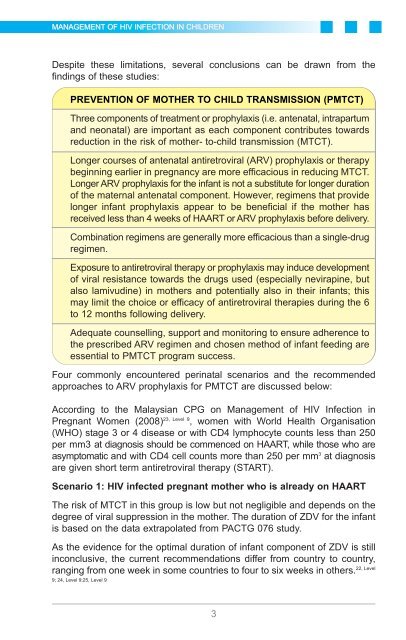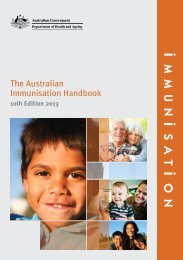3.30 MB - Academy of Medicine of Malaysia
3.30 MB - Academy of Medicine of Malaysia
3.30 MB - Academy of Medicine of Malaysia
Create successful ePaper yourself
Turn your PDF publications into a flip-book with our unique Google optimized e-Paper software.
MANAGEMENT OF HIV INFECTION IN CHILDREN<br />
Despite these limitations, several conclusions can be drawn from the<br />
findings <strong>of</strong> these studies:<br />
PREVENTION OF MOTHER TO CHILD TRANSMISSION (PMTCT)<br />
Three components <strong>of</strong> treatment or prophylaxis (i.e. antenatal, intrapartum<br />
and neonatal) are important as each component contributes towards<br />
reduction in the risk <strong>of</strong> mother- to-child transmission (MTCT).<br />
Longer courses <strong>of</strong> antenatal antiretroviral (ARV) prophylaxis or therapy<br />
beginning earlier in pregnancy are more efficacious in reducing MTCT.<br />
Longer ARV prophylaxis for the infant is not a substitute for longer duration<br />
<strong>of</strong> the maternal antenatal component. However, regimens that provide<br />
longer infant prophylaxis appear to be beneficial if the mother has<br />
received less than 4 weeks <strong>of</strong> HAART or ARV prophylaxis before delivery.<br />
Combination regimens are generally more efficacious than a single-drug<br />
regimen.<br />
Exposure to antiretroviral therapy or prophylaxis may induce development<br />
<strong>of</strong> viral resistance towards the drugs used (especially nevirapine, but<br />
also lamivudine) in mothers and potentially also in their infants; this<br />
may limit the choice or efficacy <strong>of</strong> antiretroviral therapies during the 6<br />
to 12 months following delivery.<br />
Adequate counselling, support and monitoring to ensure adherence to<br />
the prescribed ARV regimen and chosen method <strong>of</strong> infant feeding are<br />
essential to PMTCT program success.<br />
Four commonly encountered perinatal scenarios and the recommended<br />
approaches to ARV prophylaxis for PMTCT are discussed below:<br />
According to the <strong>Malaysia</strong>n CPG on Management <strong>of</strong> HIV Infection in<br />
Pregnant Women (2008) 23, Level 9 , women with World Health Organisation<br />
(WHO) stage 3 or 4 disease or with CD4 lymphocyte counts less than 250<br />
per mm3 at diagnosis should be commenced on HAART, while those who are<br />
asymptomatic and with CD4 cell counts more than 250 per mm 3 at diagnosis<br />
are given short term antiretroviral therapy (START).<br />
Scenario 1: HIV infected pregnant mother who is already on HAART<br />
The risk <strong>of</strong> MTCT in this group is low but not negligible and depends on the<br />
degree <strong>of</strong> viral suppression in the mother. The duration <strong>of</strong> ZDV for the infant<br />
is based on the data extrapolated from PACTG 076 study.<br />
As the evidence for the optimal duration <strong>of</strong> infant component <strong>of</strong> ZDV is still<br />
inconclusive, the current recommendations differ from country to country,<br />
22, Level<br />
ranging from one week in some countries to four to six weeks in others.<br />
9; 24, Level 9;25, Level 9<br />
3

















